Norman and Angevin England
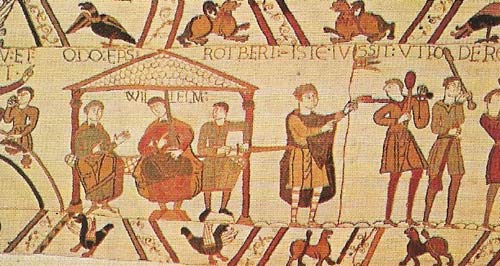
Figure 1. The conqueror and his companions, as portrayed in the Bayeux tapestry, demonstrate the esprit de corps of the Norman leaders, which was one of the secrets of their success. Bishop Odo of Bayeux (on the Conqueror's right), half-brother to William, was probably highlighted because he commissioned the tapestry.
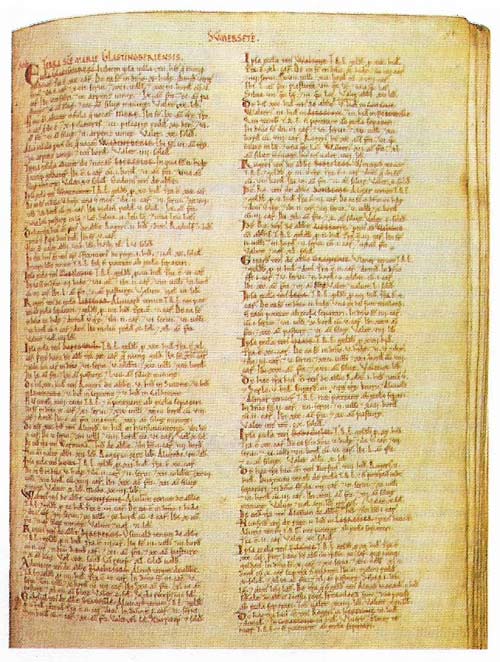
Figure 2. The Domesday Book was an astonishing monument to masterful and inventive rule. The survey was ordered by William in 1085 and completed in six months. Its precise purpose is uncertain, but it constituted a record of the wealth of the king and his principal subjects, fs stock, of the land, and the condition of the peasants who cultivated it. Teams of commissioners gathered the necessary information from jurors. This particular page describes a manor in Somerset.
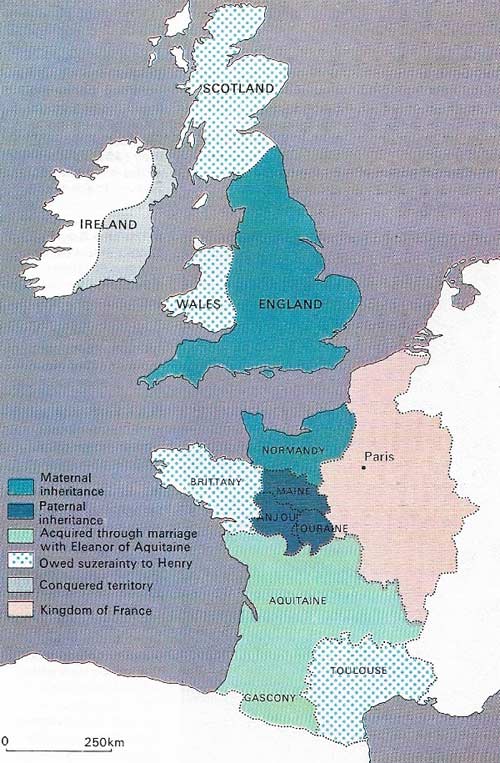
Figure 3. The Norman Empire spread farthest under Henry II, partly because of the union, via Matilda, of Norman and Angevin domains, but largely through his marriage to Eleanor of Aquitaine.
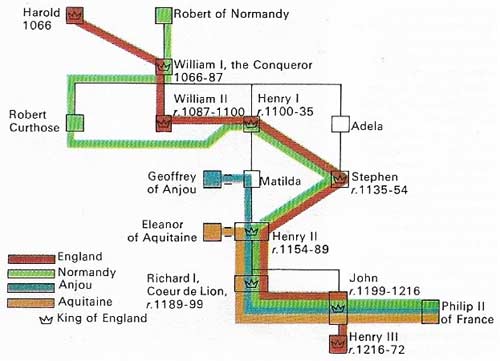
Figure 4. The network of Norman power was gradually extended by linking powerful families in marriage alliances, although civil war was needed to bring the Angevins to the English throne. England alone was acquired through conquest.
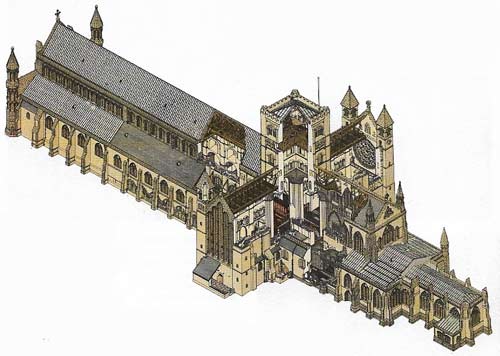
Figure 5. The Abbey Church of St Albans is one of the greatest Norman buildings. Its immensely long nave and elaborate east end, which was later rebuilt, are characteristic of the Anglo-Norman style. The Norman part (the central tower and most of the nave) was built, 1077–1093, under the direction of Abbott Paul. Although Norman in inspiration, many of the details are Anglo-Saxon since rebuilding had been planned before the Conquest.
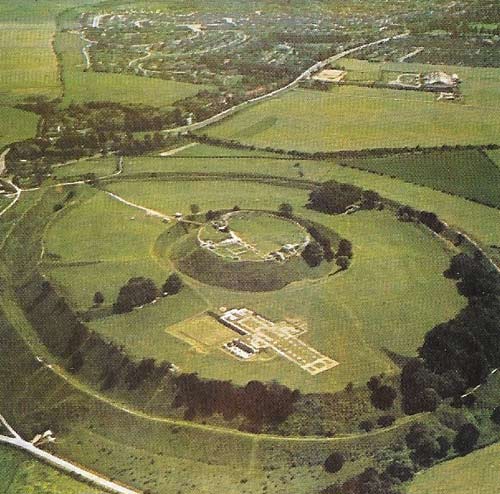
Figure 5. Old Sarum, an intact medieval town site, is dominated by the ruins of its castle. Sarum is an example of a town flourishing under royal patrons. Norman kings often resided there and William I made it a bishopric. It declined from 1222 when the bishop moved to nearby Salisbury.
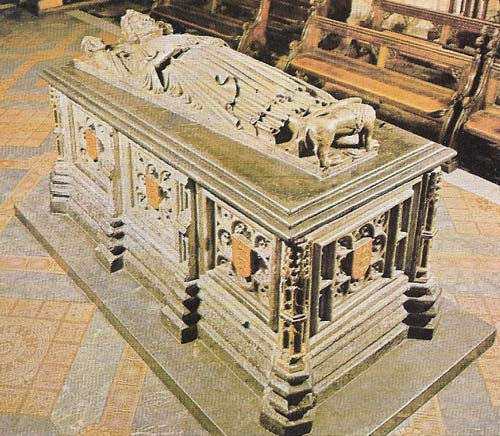
Figure 6. King John was buried at Worcester Cathedral after a reign that provoked hatred and distrust among most of his subjects, principally because he presided over the dissolution of the Angevin Empire. After 1204, when he lost most of his continental possessions, he devoted himself to their recovery. Most of the troubles of his reign were caused by the need for heavy taxation when prices were rising sharply. Abortive campaigns ended with the rebellion of the barons and the imposition on him of the Great Charter at Runnymede in 125. After the sealing of the charter the Norman Empire had to make way for the emergent English nation.
Between 1050 and 1100 Europe was transformed by the conquests of a warrior people from a section of the north French coastlands: the Normans. They overran England and southern Italy, and sealed in Scotland, Wales, the Byzantine Empire and (after the first Crusade) the Levant. These extraordinarily successful people were a closely interrelated group of families, several of them related to the Viking-descended dukes of Normandy. They took the art of cavalry warfare further than any of their contemporaries and crystallized as a distinct group under the leadership of Duke William I (1027–1087), the foremost general of his age.
The conquest of England
The Normans' greatest achievement was the conquest of England, which because of its distinctive civilization, advanced organization and great wealth was the richest prize in Europe for soldiers of fortune. Normans had begun to settle there before 1066; but the transformation of England into a Norman kingdom required the ambition of William, an adventurer like the rest. The invasion of 1066 was a corporate enterprise, ostensibly to establish William as the heir of King Edward the Confessor, but really to win the Normans new fortunes. The narrow victory of Hastings, the slow advance from Canterbury to York, and the rewarding of his companions with wide estates was only just successful, for his success created in the midst of a living society an uneasy circle of adventurers (Figure 1), in some ways less civilized than the surrounding people.
Although William hoped to rule like an Anglo-Saxon king, his enemies – King Philip of France, Malcolm of Scotland, Canute of Denmark, in league with dissident Englishmen and rebellious Normans – imposed a state of virtual siege on his dominions and forced him to original expedients, critical for the future. These included the elaborate system of military service in return for land, out of which the striking solidarity of the Anglo-Norman state was born (Figure 4), the series of mighty castles – at the Tower of London, Wallingford and Colchester, in which the grandeur of Norman ambitions can still be seen (Figure 5) – and the detailed survey of English wealth made by his order in 1086: the Domesday Book (Figure 2). The Normans transformed England, not least by reordering the diocesan structure of the Church.
Under the Norman Empire
When William died, in 1087, England and Normandy were ruled separately by his sons William Rufus (r. 1087–1100) and Robert of Normandy, but so strongly were their societies united that within a few years they were again governed by a single ruler.
The Norman Empire, ruled by Rufus's successor and Robert's supplanter Henry I (1068–1135) and his descendants, held together until 1204. For the great Norman families, England was a colonial El Dorado but Normandy was "home". Rarely have English and continental history been so intertwined, with marked effect on English civilization: Englishmen such as Adelard of Bath and John of Salisbury contributed to the European revival of learning and science; the great English cathedrals, from Durham at the beginning of the twelfth century to Canterbury at the end, were designed by the most advanced French builders; an English scholar, Nicholas Breakspear, was the first and last Englishman to become pope (as Adrian IV from 1154 to 1159); and Norman French remained for three centuries the language of the English courts and society.
England's growing prosperity
It was also a period of unprecedented prosperity for England, apparently based on sheep: England was the main supplier of wool to the Flemish textile industry. Many landlords, especially the monasteries, owned vast estates. They were progressive farmers, opening up the fens and the Yorkshire uplands. English towns [6] such as Norwich, Oxford and Salisbury developed rapidly, usually around existing episcopal seats and castles. Flourishing markets for agricultural products needed special protection and for the first time there was a definite movement towards self-governing guilds.
Norman England was also remarkably advanced in the arts of government and a series of careful monarchs (broken only by the disputed succession between Henry I's daughter Matilda and his nephew Stephen of Blois) sought to marshal England's resources rationally. On Stephen's death, Matilda's son Henry II of Anjou (reigned 1154–1189) governed with professional skill, using men who were prepared to experiment with legal forms, establish precedents for consistent action and keep records as a matter of routine. The exchequer, the jury and the common law courts are institutions that began their organized life in his reign.
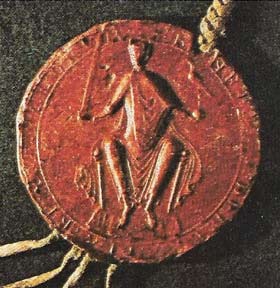 |
| The Great Seal of Henry II, despite its use in the orderly life of the realm, bears a warlike image. With the aid of capable ministers, Henry transformed the existing customs into a systematic body of law and an efficient administrative procedure. |
Their significance, however, lay in the future. At the time there were many signs that the now unwieldy empire was breaking up (Figure 3). Its French inhabitants increasingly looked to the king of France, and the last years of Henry II's reign were disrupted by rebellions, in which his sons joined. After his death the empire was held together by the sheer military genius of his son Richard I (reigned 1189–1199); but Richard's brother John, who was no general, lost it forever in only five years (Figure 6). By 1204, England had once more become a separate kingdom, enriched and transformed by a century and a half of Norman and Angevin rule.
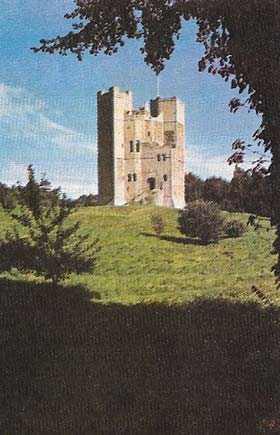 |
| Orford Castle in Suffolk, built by Henry II, was typical of the many stone castles that were constructed in every part of England. Control of these castles was the first requirement of effective authority; they could be captured only with the expenditure of much time and effort. The earliest was the Conqueror's wooden prefabricated castle set up o the beach at Hastings before the battle. Henry II showed characteristic inventiveness in the design of Orford, built between 1166 and 1172 to control the Alde estuary and the Suffolk hinterland. Its keep is polygonal outside and cylindrical within; its services are in the outer shell. |
